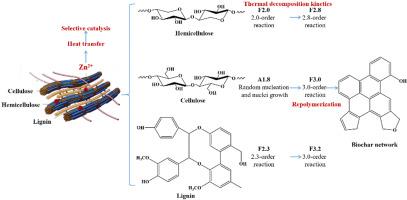Journal of Environmental Management ( IF 8.0 ) Pub Date : 2021-01-05 , DOI: 10.1016/j.jenvman.2020.111837 Changjing Li , Guozhao Ji , Yi Qu , Muhammad Irfan , Kongyun Zhu , Xuexue Wang , Aimin Li

|
The metal mineral has a complex influence on the thermal decomposition of biomass due to the sophisticated structure of biomass and parallel reactions. Therefore, the influencing mechanisms of metal minerals on biomass decomposition kinetic expressions needed to be thoroughly investigated. In this study, the decomposition of the three major components of biomass was considered separately. The iso-conversional method and integral master-plots method based on thermogravimetry were firstly introduced to explore the kinetic model changes after the introduction of zinc mineral. The thermogravimetric results showed that the presence of zinc mineral had discrepant influences on different biomass components, demoting the fragmentation of hemicellulose while promoting cellulose degradation. In the kinetic analysis, the presence of zinc mineral, the activation energy of three pseudo-components (91.90, 184.64 and 210.91 kJ mol−1) increased to 178.84, 299.05, and 359.45 kJ mol−1, respectively. The kinetic models were altered from 2.0-order reaction (F2.0) for hemicellulose, random nucleation (A1.8) for cellulose, and 2.3-order reaction (F2.3) for lignin to F2.8, F3.0, and F3.2, respectively. This indicated that the zinc mineral was beneficial to the occurrence of multimolecular repolymerization of the primary degradation products. In products analysis, the increment of biochar yields and the C4–C5 products of cellulose (especially furfural) in metal-polluted biomass pyrolysis were detected, which confirmed the simulated reaction mechanisms. The obtained results are expected to provide a mechanism reference to practical applications of metal-contaminated biomass.
中文翻译:

锌矿物质污染对玉米生物质热解动力学及产物特性的影响机理
由于生物质的复杂结构和平行反应,金属矿物对生物质的热分解具有复杂的影响。因此,金属矿物对生物质分解动力学表达的影响机理有待深入研究。在这项研究中,分别考虑了生物质的三个主要成分的分解。首先介绍了基于热重分析的等转换法和积分主图法,以探讨锌矿物引入后的动力学模型变化。热重分析结果表明,锌矿物质的存在对不同的生物质组分有不同的影响,降低了半纤维素的碎片,同时促进了纤维素的降解。在动力学分析中,锌矿物质的存在-1)分别增加到178.84、299.05和359.45 kJ mol -1。动力学模型从半纤维素的2.0级反应(F2.0),纤维素的随机成核(A1.8)和木质素的2.3级反应(F2.3)更改为F2.8,F3.0和F3.2。这表明锌矿物质有利于初级降解产物的多分子再聚合。在产品分析中,检测到金属污染的生物质热解过程中生物炭产量的增加和纤维素(尤其是糠醛)的C4–C5产物增加,从而证实了模拟的反应机理。预期获得的结果将为金属污染的生物质的实际应用提供机制参考。











































 京公网安备 11010802027423号
京公网安备 11010802027423号